Case Study Analysis: Leadership and Management at NHS England
VerifiedAdded on 2023/01/11
|13
|4919
|22
Case Study
AI Summary
This case study examines leadership and management practices within NHS England, focusing on issues of autocratic leadership and its impact on patient care and staff morale. It presents a reflective account using Gibbs' Reflective Model to analyze the situation, detailing the junior manager's observations, feelings, and evaluations of the problems. The case study highlights concerns about the manager's exercise of power, the lack of patient-centric care, and the resulting de-motivation of staff. The analysis includes a discussion of both the positive and negative elements of the experience, such as the learning gained about leadership theories and the negative consequences of the prevailing management style. The study concludes with a comprehensive overview of the challenges and potential improvements within the NHS England setting.
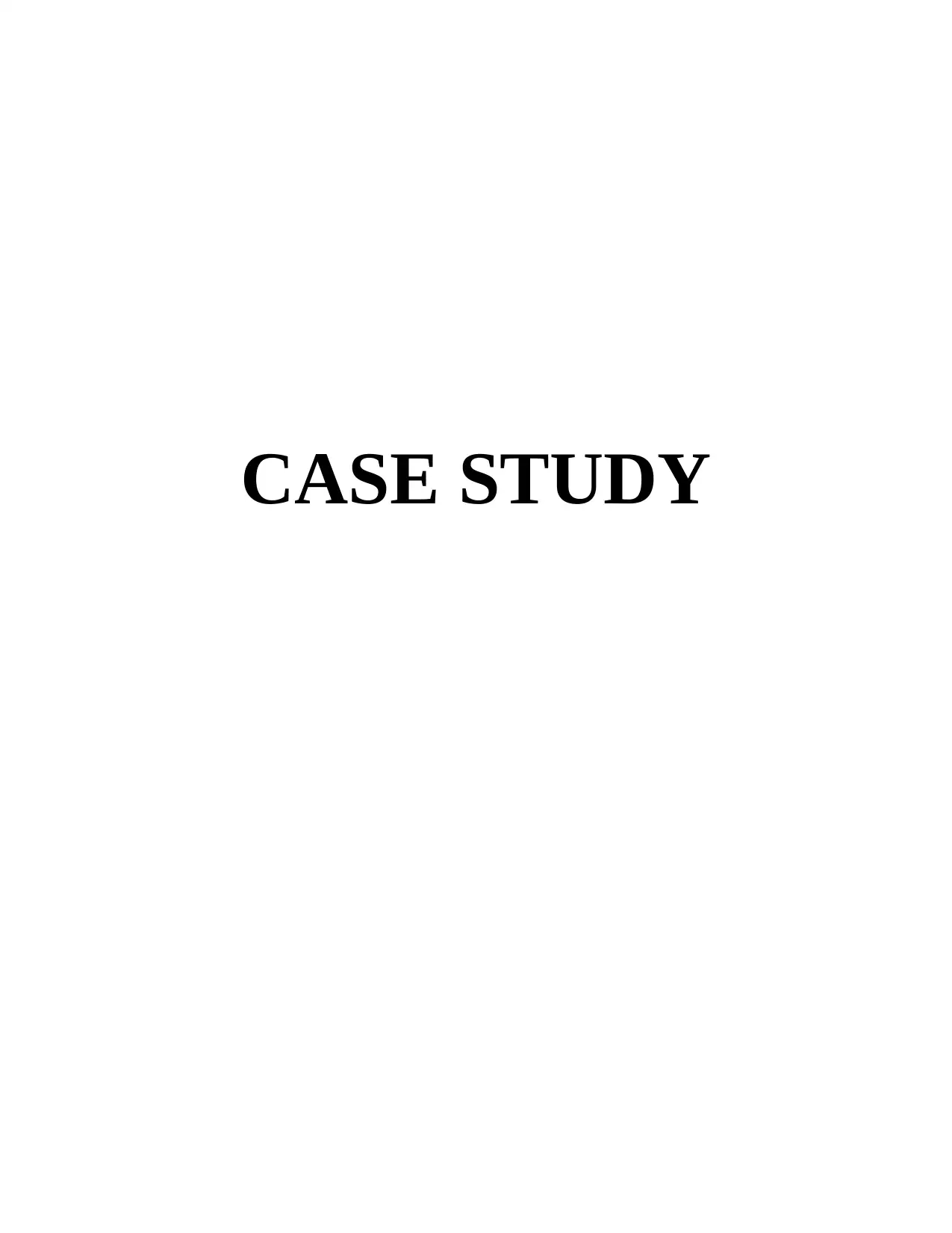
CASE STUDY
Paraphrase This Document
Need a fresh take? Get an instant paraphrase of this document with our AI Paraphraser
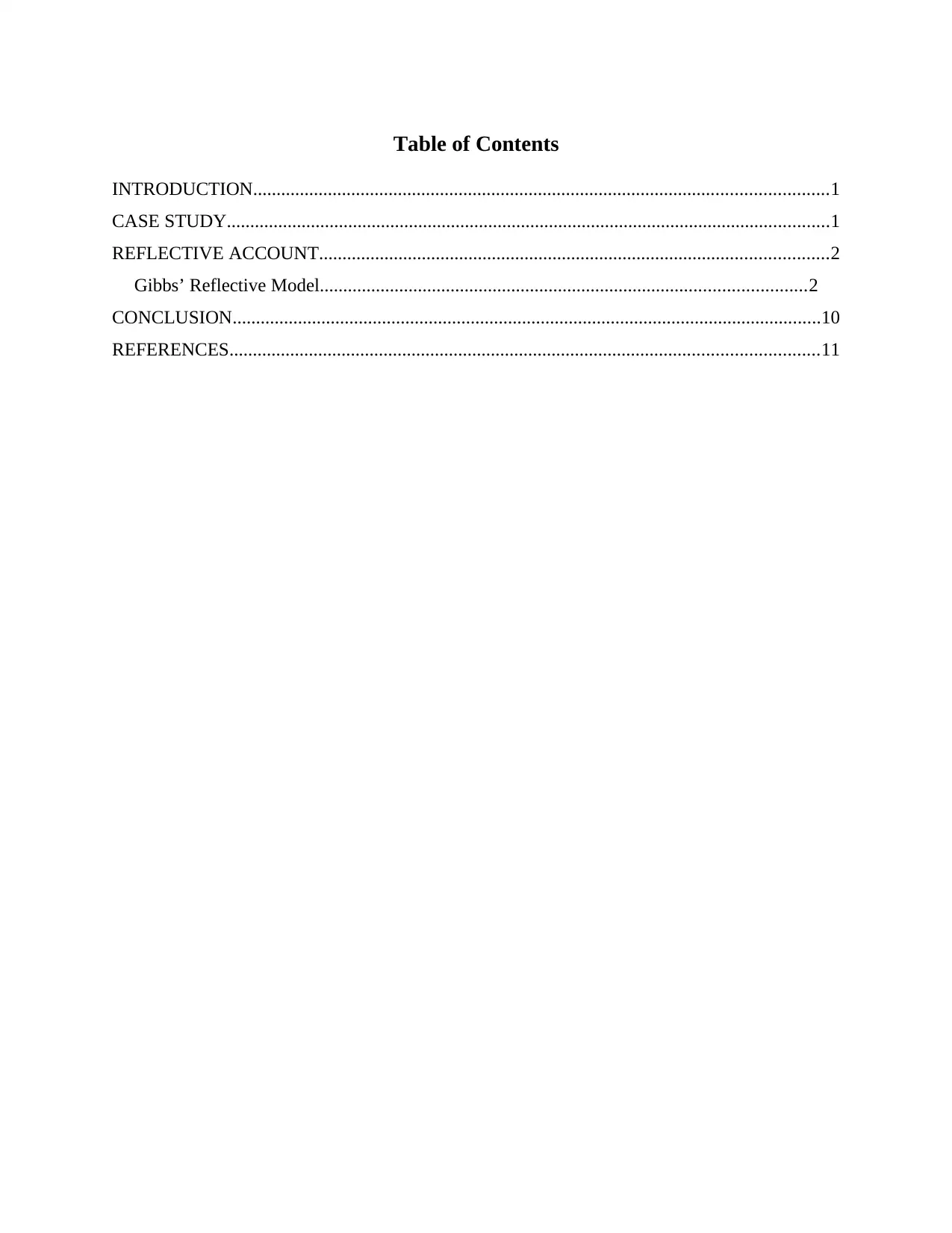
Table of Contents
INTRODUCTION...........................................................................................................................1
CASE STUDY.................................................................................................................................1
REFLECTIVE ACCOUNT.............................................................................................................2
Gibbs’ Reflective Model........................................................................................................2
CONCLUSION..............................................................................................................................10
REFERENCES..............................................................................................................................11
INTRODUCTION...........................................................................................................................1
CASE STUDY.................................................................................................................................1
REFLECTIVE ACCOUNT.............................................................................................................2
Gibbs’ Reflective Model........................................................................................................2
CONCLUSION..............................................................................................................................10
REFERENCES..............................................................................................................................11
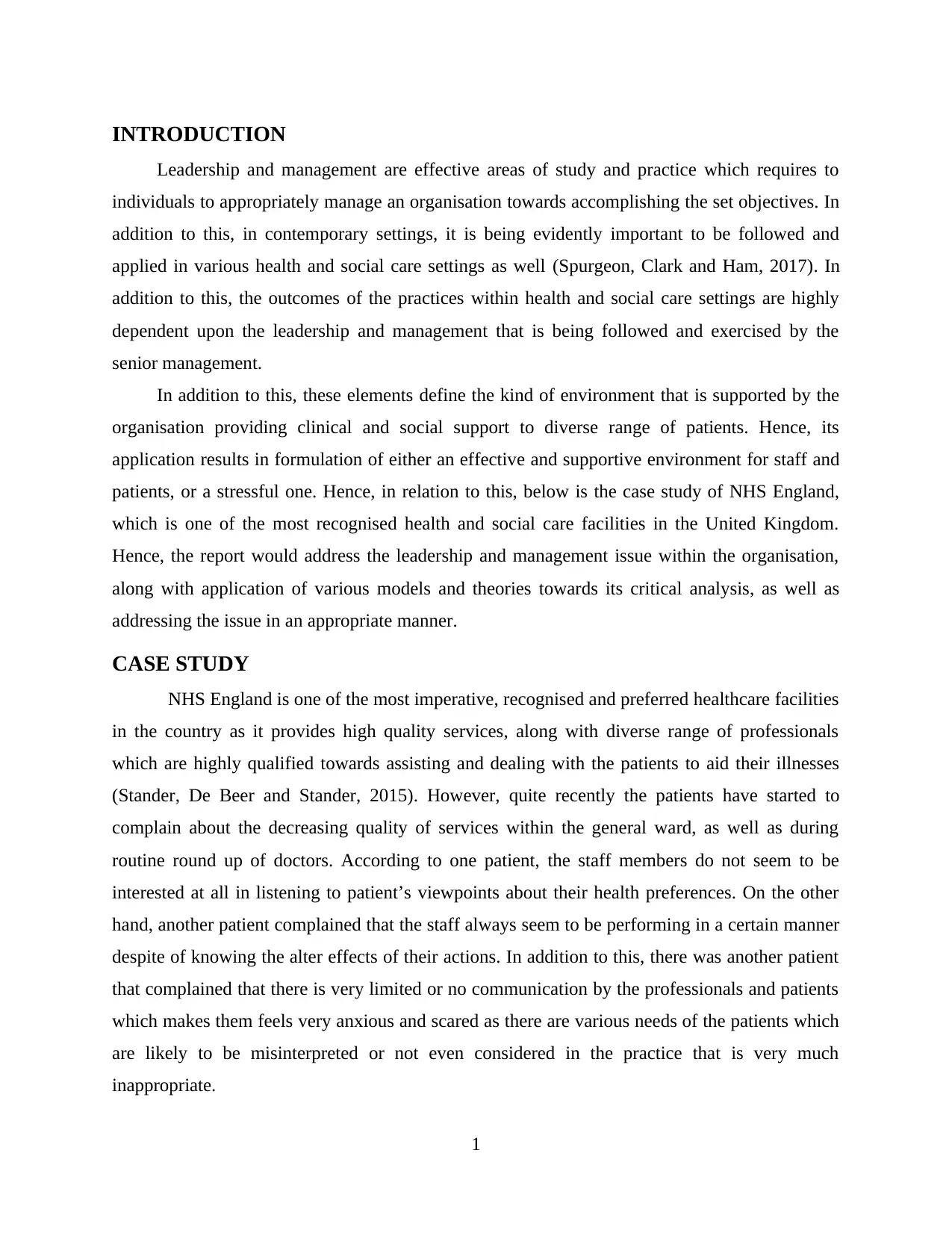
INTRODUCTION
Leadership and management are effective areas of study and practice which requires to
individuals to appropriately manage an organisation towards accomplishing the set objectives. In
addition to this, in contemporary settings, it is being evidently important to be followed and
applied in various health and social care settings as well (Spurgeon, Clark and Ham, 2017). In
addition to this, the outcomes of the practices within health and social care settings are highly
dependent upon the leadership and management that is being followed and exercised by the
senior management.
In addition to this, these elements define the kind of environment that is supported by the
organisation providing clinical and social support to diverse range of patients. Hence, its
application results in formulation of either an effective and supportive environment for staff and
patients, or a stressful one. Hence, in relation to this, below is the case study of NHS England,
which is one of the most recognised health and social care facilities in the United Kingdom.
Hence, the report would address the leadership and management issue within the organisation,
along with application of various models and theories towards its critical analysis, as well as
addressing the issue in an appropriate manner.
CASE STUDY
NHS England is one of the most imperative, recognised and preferred healthcare facilities
in the country as it provides high quality services, along with diverse range of professionals
which are highly qualified towards assisting and dealing with the patients to aid their illnesses
(Stander, De Beer and Stander, 2015). However, quite recently the patients have started to
complain about the decreasing quality of services within the general ward, as well as during
routine round up of doctors. According to one patient, the staff members do not seem to be
interested at all in listening to patient’s viewpoints about their health preferences. On the other
hand, another patient complained that the staff always seem to be performing in a certain manner
despite of knowing the alter effects of their actions. In addition to this, there was another patient
that complained that there is very limited or no communication by the professionals and patients
which makes them feels very anxious and scared as there are various needs of the patients which
are likely to be misinterpreted or not even considered in the practice that is very much
inappropriate.
1
Leadership and management are effective areas of study and practice which requires to
individuals to appropriately manage an organisation towards accomplishing the set objectives. In
addition to this, in contemporary settings, it is being evidently important to be followed and
applied in various health and social care settings as well (Spurgeon, Clark and Ham, 2017). In
addition to this, the outcomes of the practices within health and social care settings are highly
dependent upon the leadership and management that is being followed and exercised by the
senior management.
In addition to this, these elements define the kind of environment that is supported by the
organisation providing clinical and social support to diverse range of patients. Hence, its
application results in formulation of either an effective and supportive environment for staff and
patients, or a stressful one. Hence, in relation to this, below is the case study of NHS England,
which is one of the most recognised health and social care facilities in the United Kingdom.
Hence, the report would address the leadership and management issue within the organisation,
along with application of various models and theories towards its critical analysis, as well as
addressing the issue in an appropriate manner.
CASE STUDY
NHS England is one of the most imperative, recognised and preferred healthcare facilities
in the country as it provides high quality services, along with diverse range of professionals
which are highly qualified towards assisting and dealing with the patients to aid their illnesses
(Stander, De Beer and Stander, 2015). However, quite recently the patients have started to
complain about the decreasing quality of services within the general ward, as well as during
routine round up of doctors. According to one patient, the staff members do not seem to be
interested at all in listening to patient’s viewpoints about their health preferences. On the other
hand, another patient complained that the staff always seem to be performing in a certain manner
despite of knowing the alter effects of their actions. In addition to this, there was another patient
that complained that there is very limited or no communication by the professionals and patients
which makes them feels very anxious and scared as there are various needs of the patients which
are likely to be misinterpreted or not even considered in the practice that is very much
inappropriate.
1
⊘ This is a preview!⊘
Do you want full access?
Subscribe today to unlock all pages.

Trusted by 1+ million students worldwide
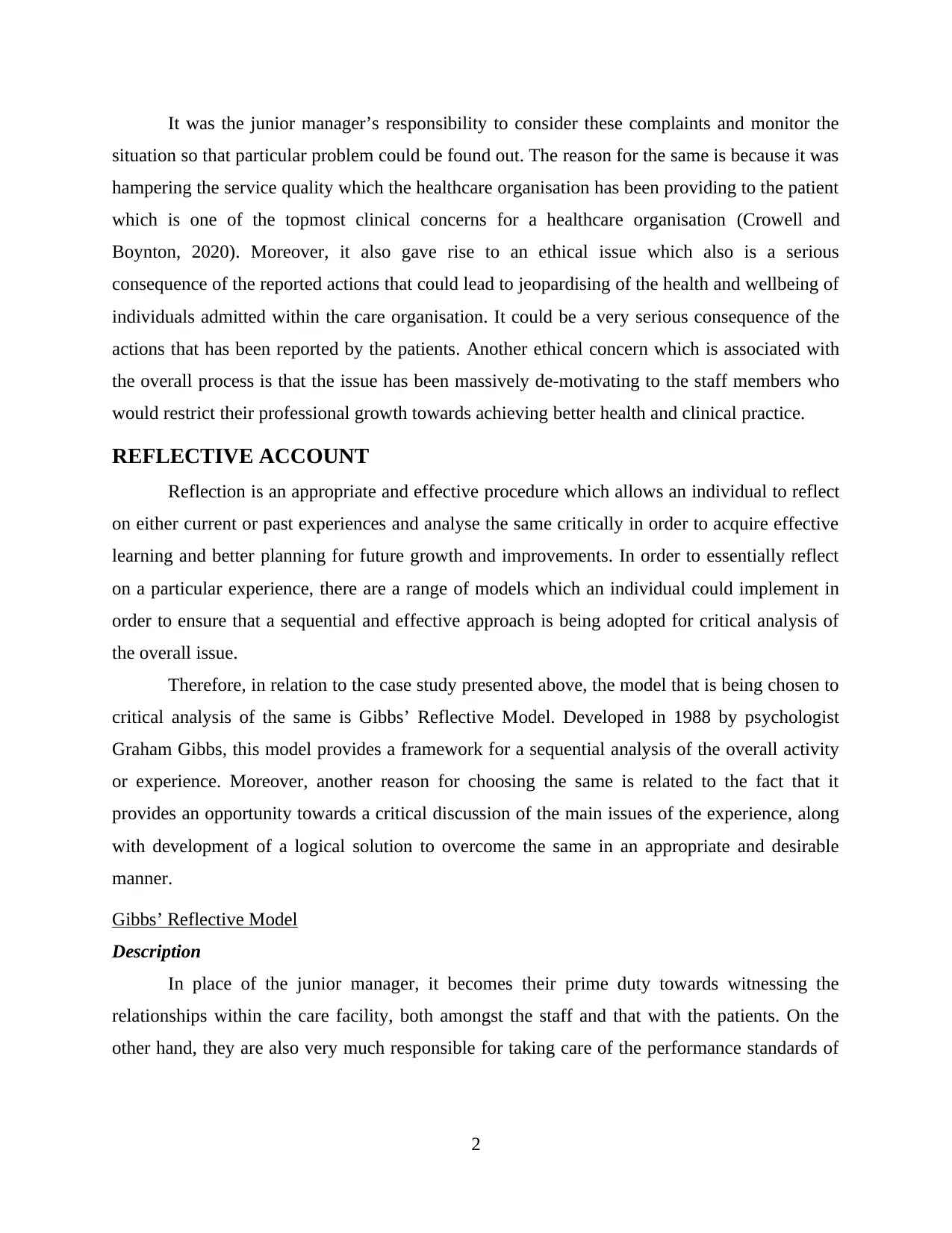
It was the junior manager’s responsibility to consider these complaints and monitor the
situation so that particular problem could be found out. The reason for the same is because it was
hampering the service quality which the healthcare organisation has been providing to the patient
which is one of the topmost clinical concerns for a healthcare organisation (Crowell and
Boynton, 2020). Moreover, it also gave rise to an ethical issue which also is a serious
consequence of the reported actions that could lead to jeopardising of the health and wellbeing of
individuals admitted within the care organisation. It could be a very serious consequence of the
actions that has been reported by the patients. Another ethical concern which is associated with
the overall process is that the issue has been massively de-motivating to the staff members who
would restrict their professional growth towards achieving better health and clinical practice.
REFLECTIVE ACCOUNT
Reflection is an appropriate and effective procedure which allows an individual to reflect
on either current or past experiences and analyse the same critically in order to acquire effective
learning and better planning for future growth and improvements. In order to essentially reflect
on a particular experience, there are a range of models which an individual could implement in
order to ensure that a sequential and effective approach is being adopted for critical analysis of
the overall issue.
Therefore, in relation to the case study presented above, the model that is being chosen to
critical analysis of the same is Gibbs’ Reflective Model. Developed in 1988 by psychologist
Graham Gibbs, this model provides a framework for a sequential analysis of the overall activity
or experience. Moreover, another reason for choosing the same is related to the fact that it
provides an opportunity towards a critical discussion of the main issues of the experience, along
with development of a logical solution to overcome the same in an appropriate and desirable
manner.
Gibbs’ Reflective Model
Description
In place of the junior manager, it becomes their prime duty towards witnessing the
relationships within the care facility, both amongst the staff and that with the patients. On the
other hand, they are also very much responsible for taking care of the performance standards of
2
situation so that particular problem could be found out. The reason for the same is because it was
hampering the service quality which the healthcare organisation has been providing to the patient
which is one of the topmost clinical concerns for a healthcare organisation (Crowell and
Boynton, 2020). Moreover, it also gave rise to an ethical issue which also is a serious
consequence of the reported actions that could lead to jeopardising of the health and wellbeing of
individuals admitted within the care organisation. It could be a very serious consequence of the
actions that has been reported by the patients. Another ethical concern which is associated with
the overall process is that the issue has been massively de-motivating to the staff members who
would restrict their professional growth towards achieving better health and clinical practice.
REFLECTIVE ACCOUNT
Reflection is an appropriate and effective procedure which allows an individual to reflect
on either current or past experiences and analyse the same critically in order to acquire effective
learning and better planning for future growth and improvements. In order to essentially reflect
on a particular experience, there are a range of models which an individual could implement in
order to ensure that a sequential and effective approach is being adopted for critical analysis of
the overall issue.
Therefore, in relation to the case study presented above, the model that is being chosen to
critical analysis of the same is Gibbs’ Reflective Model. Developed in 1988 by psychologist
Graham Gibbs, this model provides a framework for a sequential analysis of the overall activity
or experience. Moreover, another reason for choosing the same is related to the fact that it
provides an opportunity towards a critical discussion of the main issues of the experience, along
with development of a logical solution to overcome the same in an appropriate and desirable
manner.
Gibbs’ Reflective Model
Description
In place of the junior manager, it becomes their prime duty towards witnessing the
relationships within the care facility, both amongst the staff and that with the patients. On the
other hand, they are also very much responsible for taking care of the performance standards of
2
Paraphrase This Document
Need a fresh take? Get an instant paraphrase of this document with our AI Paraphraser
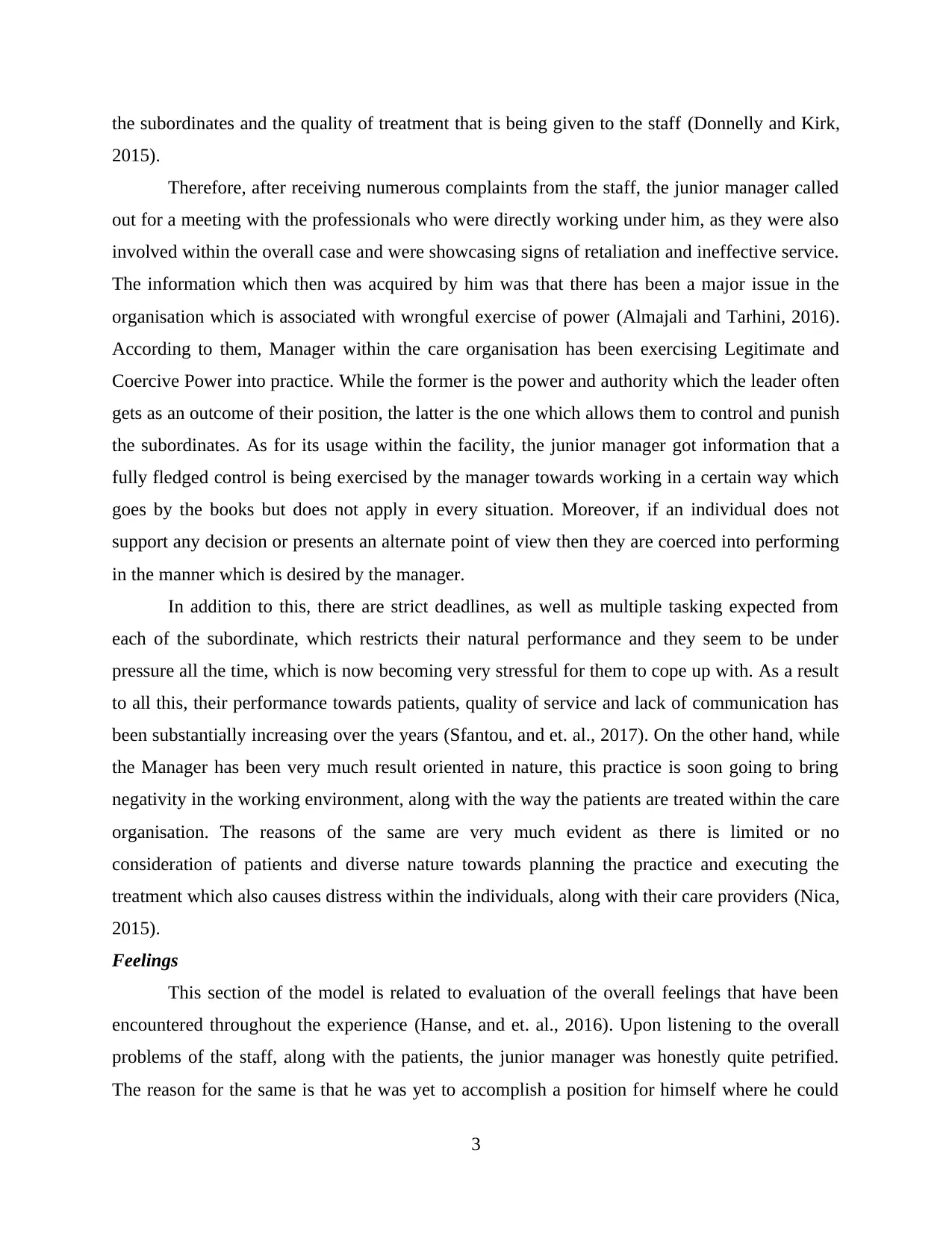
the subordinates and the quality of treatment that is being given to the staff (Donnelly and Kirk,
2015).
Therefore, after receiving numerous complaints from the staff, the junior manager called
out for a meeting with the professionals who were directly working under him, as they were also
involved within the overall case and were showcasing signs of retaliation and ineffective service.
The information which then was acquired by him was that there has been a major issue in the
organisation which is associated with wrongful exercise of power (Almajali and Tarhini, 2016).
According to them, Manager within the care organisation has been exercising Legitimate and
Coercive Power into practice. While the former is the power and authority which the leader often
gets as an outcome of their position, the latter is the one which allows them to control and punish
the subordinates. As for its usage within the facility, the junior manager got information that a
fully fledged control is being exercised by the manager towards working in a certain way which
goes by the books but does not apply in every situation. Moreover, if an individual does not
support any decision or presents an alternate point of view then they are coerced into performing
in the manner which is desired by the manager.
In addition to this, there are strict deadlines, as well as multiple tasking expected from
each of the subordinate, which restricts their natural performance and they seem to be under
pressure all the time, which is now becoming very stressful for them to cope up with. As a result
to all this, their performance towards patients, quality of service and lack of communication has
been substantially increasing over the years (Sfantou, and et. al., 2017). On the other hand, while
the Manager has been very much result oriented in nature, this practice is soon going to bring
negativity in the working environment, along with the way the patients are treated within the care
organisation. The reasons of the same are very much evident as there is limited or no
consideration of patients and diverse nature towards planning the practice and executing the
treatment which also causes distress within the individuals, along with their care providers (Nica,
2015).
Feelings
This section of the model is related to evaluation of the overall feelings that have been
encountered throughout the experience (Hanse, and et. al., 2016). Upon listening to the overall
problems of the staff, along with the patients, the junior manager was honestly quite petrified.
The reason for the same is that he was yet to accomplish a position for himself where he could
3
2015).
Therefore, after receiving numerous complaints from the staff, the junior manager called
out for a meeting with the professionals who were directly working under him, as they were also
involved within the overall case and were showcasing signs of retaliation and ineffective service.
The information which then was acquired by him was that there has been a major issue in the
organisation which is associated with wrongful exercise of power (Almajali and Tarhini, 2016).
According to them, Manager within the care organisation has been exercising Legitimate and
Coercive Power into practice. While the former is the power and authority which the leader often
gets as an outcome of their position, the latter is the one which allows them to control and punish
the subordinates. As for its usage within the facility, the junior manager got information that a
fully fledged control is being exercised by the manager towards working in a certain way which
goes by the books but does not apply in every situation. Moreover, if an individual does not
support any decision or presents an alternate point of view then they are coerced into performing
in the manner which is desired by the manager.
In addition to this, there are strict deadlines, as well as multiple tasking expected from
each of the subordinate, which restricts their natural performance and they seem to be under
pressure all the time, which is now becoming very stressful for them to cope up with. As a result
to all this, their performance towards patients, quality of service and lack of communication has
been substantially increasing over the years (Sfantou, and et. al., 2017). On the other hand, while
the Manager has been very much result oriented in nature, this practice is soon going to bring
negativity in the working environment, along with the way the patients are treated within the care
organisation. The reasons of the same are very much evident as there is limited or no
consideration of patients and diverse nature towards planning the practice and executing the
treatment which also causes distress within the individuals, along with their care providers (Nica,
2015).
Feelings
This section of the model is related to evaluation of the overall feelings that have been
encountered throughout the experience (Hanse, and et. al., 2016). Upon listening to the overall
problems of the staff, along with the patients, the junior manager was honestly quite petrified.
The reason for the same is that he was yet to accomplish a position for himself where he could
3
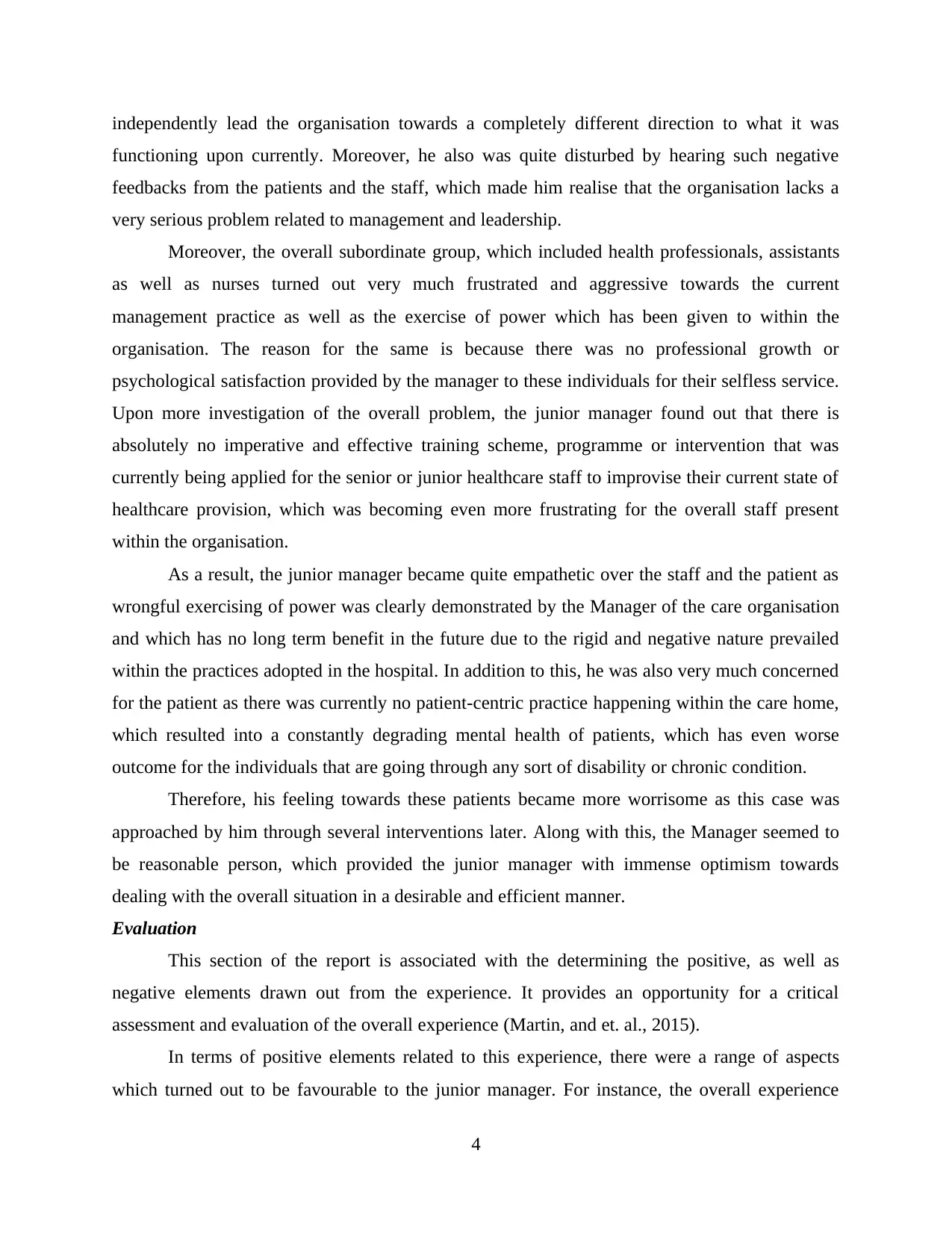
independently lead the organisation towards a completely different direction to what it was
functioning upon currently. Moreover, he also was quite disturbed by hearing such negative
feedbacks from the patients and the staff, which made him realise that the organisation lacks a
very serious problem related to management and leadership.
Moreover, the overall subordinate group, which included health professionals, assistants
as well as nurses turned out very much frustrated and aggressive towards the current
management practice as well as the exercise of power which has been given to within the
organisation. The reason for the same is because there was no professional growth or
psychological satisfaction provided by the manager to these individuals for their selfless service.
Upon more investigation of the overall problem, the junior manager found out that there is
absolutely no imperative and effective training scheme, programme or intervention that was
currently being applied for the senior or junior healthcare staff to improvise their current state of
healthcare provision, which was becoming even more frustrating for the overall staff present
within the organisation.
As a result, the junior manager became quite empathetic over the staff and the patient as
wrongful exercising of power was clearly demonstrated by the Manager of the care organisation
and which has no long term benefit in the future due to the rigid and negative nature prevailed
within the practices adopted in the hospital. In addition to this, he was also very much concerned
for the patient as there was currently no patient-centric practice happening within the care home,
which resulted into a constantly degrading mental health of patients, which has even worse
outcome for the individuals that are going through any sort of disability or chronic condition.
Therefore, his feeling towards these patients became more worrisome as this case was
approached by him through several interventions later. Along with this, the Manager seemed to
be reasonable person, which provided the junior manager with immense optimism towards
dealing with the overall situation in a desirable and efficient manner.
Evaluation
This section of the report is associated with the determining the positive, as well as
negative elements drawn out from the experience. It provides an opportunity for a critical
assessment and evaluation of the overall experience (Martin, and et. al., 2015).
In terms of positive elements related to this experience, there were a range of aspects
which turned out to be favourable to the junior manager. For instance, the overall experience
4
functioning upon currently. Moreover, he also was quite disturbed by hearing such negative
feedbacks from the patients and the staff, which made him realise that the organisation lacks a
very serious problem related to management and leadership.
Moreover, the overall subordinate group, which included health professionals, assistants
as well as nurses turned out very much frustrated and aggressive towards the current
management practice as well as the exercise of power which has been given to within the
organisation. The reason for the same is because there was no professional growth or
psychological satisfaction provided by the manager to these individuals for their selfless service.
Upon more investigation of the overall problem, the junior manager found out that there is
absolutely no imperative and effective training scheme, programme or intervention that was
currently being applied for the senior or junior healthcare staff to improvise their current state of
healthcare provision, which was becoming even more frustrating for the overall staff present
within the organisation.
As a result, the junior manager became quite empathetic over the staff and the patient as
wrongful exercising of power was clearly demonstrated by the Manager of the care organisation
and which has no long term benefit in the future due to the rigid and negative nature prevailed
within the practices adopted in the hospital. In addition to this, he was also very much concerned
for the patient as there was currently no patient-centric practice happening within the care home,
which resulted into a constantly degrading mental health of patients, which has even worse
outcome for the individuals that are going through any sort of disability or chronic condition.
Therefore, his feeling towards these patients became more worrisome as this case was
approached by him through several interventions later. Along with this, the Manager seemed to
be reasonable person, which provided the junior manager with immense optimism towards
dealing with the overall situation in a desirable and efficient manner.
Evaluation
This section of the report is associated with the determining the positive, as well as
negative elements drawn out from the experience. It provides an opportunity for a critical
assessment and evaluation of the overall experience (Martin, and et. al., 2015).
In terms of positive elements related to this experience, there were a range of aspects
which turned out to be favourable to the junior manager. For instance, the overall experience
4
⊘ This is a preview!⊘
Do you want full access?
Subscribe today to unlock all pages.

Trusted by 1+ million students worldwide
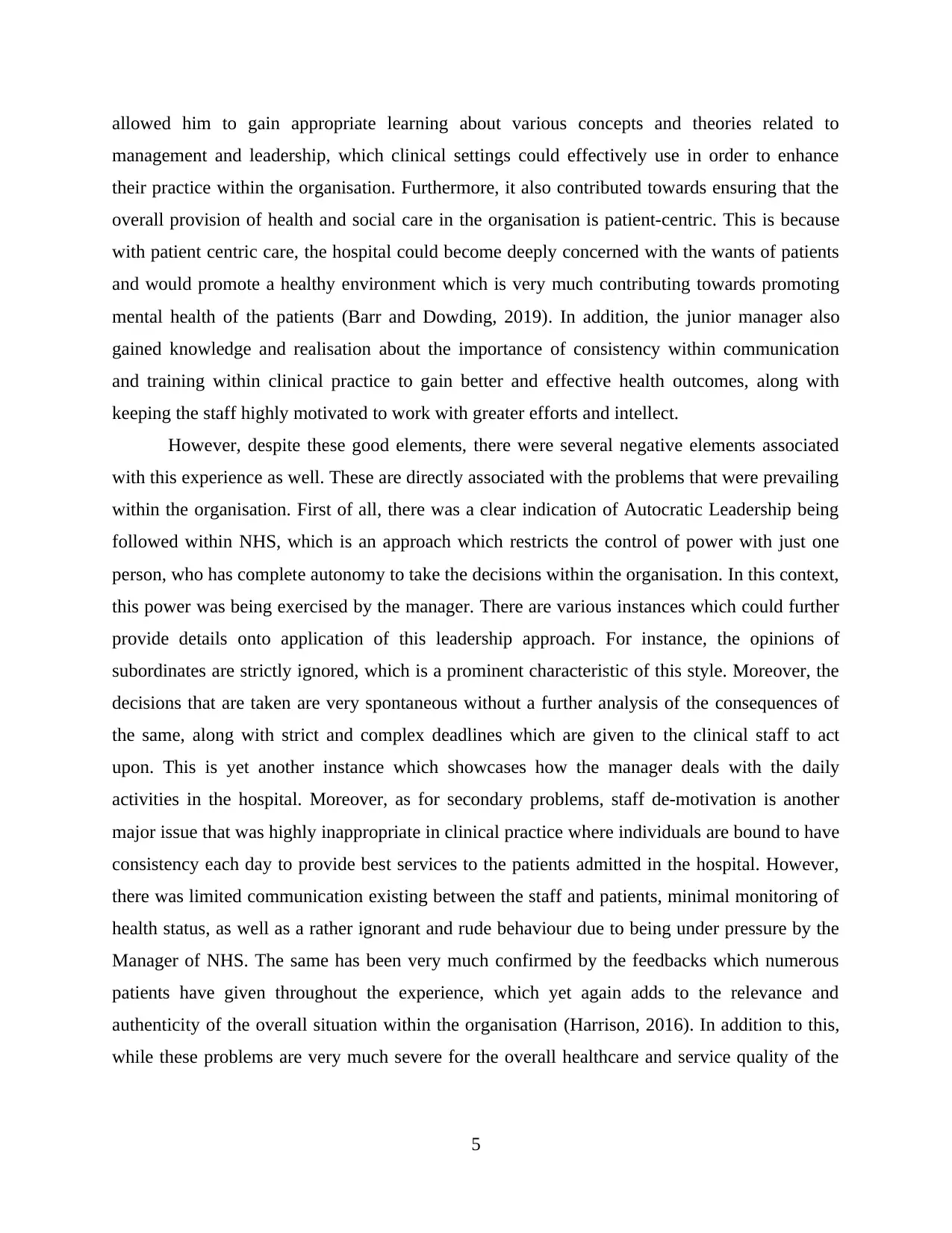
allowed him to gain appropriate learning about various concepts and theories related to
management and leadership, which clinical settings could effectively use in order to enhance
their practice within the organisation. Furthermore, it also contributed towards ensuring that the
overall provision of health and social care in the organisation is patient-centric. This is because
with patient centric care, the hospital could become deeply concerned with the wants of patients
and would promote a healthy environment which is very much contributing towards promoting
mental health of the patients (Barr and Dowding, 2019). In addition, the junior manager also
gained knowledge and realisation about the importance of consistency within communication
and training within clinical practice to gain better and effective health outcomes, along with
keeping the staff highly motivated to work with greater efforts and intellect.
However, despite these good elements, there were several negative elements associated
with this experience as well. These are directly associated with the problems that were prevailing
within the organisation. First of all, there was a clear indication of Autocratic Leadership being
followed within NHS, which is an approach which restricts the control of power with just one
person, who has complete autonomy to take the decisions within the organisation. In this context,
this power was being exercised by the manager. There are various instances which could further
provide details onto application of this leadership approach. For instance, the opinions of
subordinates are strictly ignored, which is a prominent characteristic of this style. Moreover, the
decisions that are taken are very spontaneous without a further analysis of the consequences of
the same, along with strict and complex deadlines which are given to the clinical staff to act
upon. This is yet another instance which showcases how the manager deals with the daily
activities in the hospital. Moreover, as for secondary problems, staff de-motivation is another
major issue that was highly inappropriate in clinical practice where individuals are bound to have
consistency each day to provide best services to the patients admitted in the hospital. However,
there was limited communication existing between the staff and patients, minimal monitoring of
health status, as well as a rather ignorant and rude behaviour due to being under pressure by the
Manager of NHS. The same has been very much confirmed by the feedbacks which numerous
patients have given throughout the experience, which yet again adds to the relevance and
authenticity of the overall situation within the organisation (Harrison, 2016). In addition to this,
while these problems are very much severe for the overall healthcare and service quality of the
5
management and leadership, which clinical settings could effectively use in order to enhance
their practice within the organisation. Furthermore, it also contributed towards ensuring that the
overall provision of health and social care in the organisation is patient-centric. This is because
with patient centric care, the hospital could become deeply concerned with the wants of patients
and would promote a healthy environment which is very much contributing towards promoting
mental health of the patients (Barr and Dowding, 2019). In addition, the junior manager also
gained knowledge and realisation about the importance of consistency within communication
and training within clinical practice to gain better and effective health outcomes, along with
keeping the staff highly motivated to work with greater efforts and intellect.
However, despite these good elements, there were several negative elements associated
with this experience as well. These are directly associated with the problems that were prevailing
within the organisation. First of all, there was a clear indication of Autocratic Leadership being
followed within NHS, which is an approach which restricts the control of power with just one
person, who has complete autonomy to take the decisions within the organisation. In this context,
this power was being exercised by the manager. There are various instances which could further
provide details onto application of this leadership approach. For instance, the opinions of
subordinates are strictly ignored, which is a prominent characteristic of this style. Moreover, the
decisions that are taken are very spontaneous without a further analysis of the consequences of
the same, along with strict and complex deadlines which are given to the clinical staff to act
upon. This is yet another instance which showcases how the manager deals with the daily
activities in the hospital. Moreover, as for secondary problems, staff de-motivation is another
major issue that was highly inappropriate in clinical practice where individuals are bound to have
consistency each day to provide best services to the patients admitted in the hospital. However,
there was limited communication existing between the staff and patients, minimal monitoring of
health status, as well as a rather ignorant and rude behaviour due to being under pressure by the
Manager of NHS. The same has been very much confirmed by the feedbacks which numerous
patients have given throughout the experience, which yet again adds to the relevance and
authenticity of the overall situation within the organisation (Harrison, 2016). In addition to this,
while these problems are very much severe for the overall healthcare and service quality of the
5
Paraphrase This Document
Need a fresh take? Get an instant paraphrase of this document with our AI Paraphraser
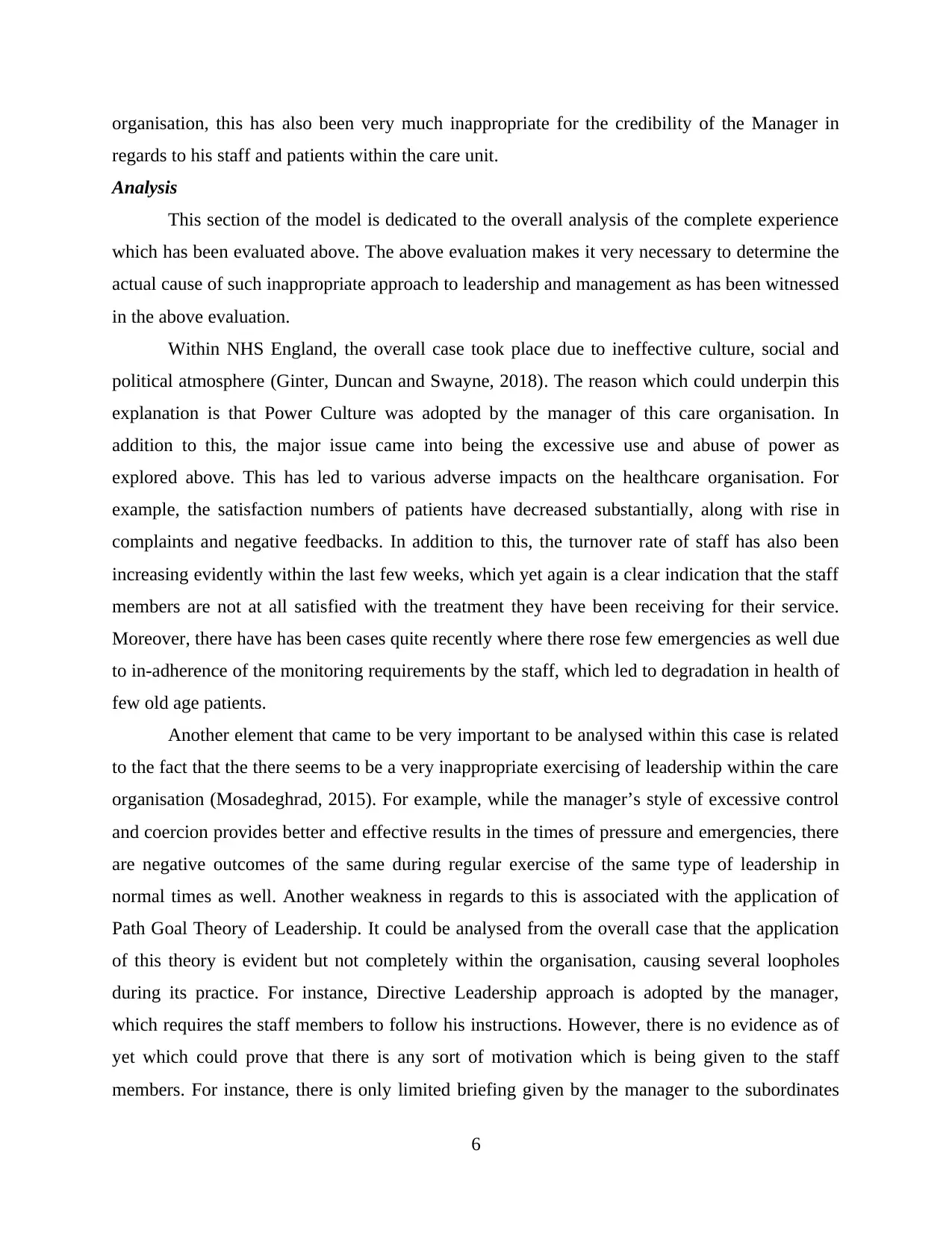
organisation, this has also been very much inappropriate for the credibility of the Manager in
regards to his staff and patients within the care unit.
Analysis
This section of the model is dedicated to the overall analysis of the complete experience
which has been evaluated above. The above evaluation makes it very necessary to determine the
actual cause of such inappropriate approach to leadership and management as has been witnessed
in the above evaluation.
Within NHS England, the overall case took place due to ineffective culture, social and
political atmosphere (Ginter, Duncan and Swayne, 2018). The reason which could underpin this
explanation is that Power Culture was adopted by the manager of this care organisation. In
addition to this, the major issue came into being the excessive use and abuse of power as
explored above. This has led to various adverse impacts on the healthcare organisation. For
example, the satisfaction numbers of patients have decreased substantially, along with rise in
complaints and negative feedbacks. In addition to this, the turnover rate of staff has also been
increasing evidently within the last few weeks, which yet again is a clear indication that the staff
members are not at all satisfied with the treatment they have been receiving for their service.
Moreover, there have has been cases quite recently where there rose few emergencies as well due
to in-adherence of the monitoring requirements by the staff, which led to degradation in health of
few old age patients.
Another element that came to be very important to be analysed within this case is related
to the fact that the there seems to be a very inappropriate exercising of leadership within the care
organisation (Mosadeghrad, 2015). For example, while the manager’s style of excessive control
and coercion provides better and effective results in the times of pressure and emergencies, there
are negative outcomes of the same during regular exercise of the same type of leadership in
normal times as well. Another weakness in regards to this is associated with the application of
Path Goal Theory of Leadership. It could be analysed from the overall case that the application
of this theory is evident but not completely within the organisation, causing several loopholes
during its practice. For instance, Directive Leadership approach is adopted by the manager,
which requires the staff members to follow his instructions. However, there is no evidence as of
yet which could prove that there is any sort of motivation which is being given to the staff
members. For instance, there is only limited briefing given by the manager to the subordinates
6
regards to his staff and patients within the care unit.
Analysis
This section of the model is dedicated to the overall analysis of the complete experience
which has been evaluated above. The above evaluation makes it very necessary to determine the
actual cause of such inappropriate approach to leadership and management as has been witnessed
in the above evaluation.
Within NHS England, the overall case took place due to ineffective culture, social and
political atmosphere (Ginter, Duncan and Swayne, 2018). The reason which could underpin this
explanation is that Power Culture was adopted by the manager of this care organisation. In
addition to this, the major issue came into being the excessive use and abuse of power as
explored above. This has led to various adverse impacts on the healthcare organisation. For
example, the satisfaction numbers of patients have decreased substantially, along with rise in
complaints and negative feedbacks. In addition to this, the turnover rate of staff has also been
increasing evidently within the last few weeks, which yet again is a clear indication that the staff
members are not at all satisfied with the treatment they have been receiving for their service.
Moreover, there have has been cases quite recently where there rose few emergencies as well due
to in-adherence of the monitoring requirements by the staff, which led to degradation in health of
few old age patients.
Another element that came to be very important to be analysed within this case is related
to the fact that the there seems to be a very inappropriate exercising of leadership within the care
organisation (Mosadeghrad, 2015). For example, while the manager’s style of excessive control
and coercion provides better and effective results in the times of pressure and emergencies, there
are negative outcomes of the same during regular exercise of the same type of leadership in
normal times as well. Another weakness in regards to this is associated with the application of
Path Goal Theory of Leadership. It could be analysed from the overall case that the application
of this theory is evident but not completely within the organisation, causing several loopholes
during its practice. For instance, Directive Leadership approach is adopted by the manager,
which requires the staff members to follow his instructions. However, there is no evidence as of
yet which could prove that there is any sort of motivation which is being given to the staff
members. For instance, there is only limited briefing given by the manager to the subordinates
6
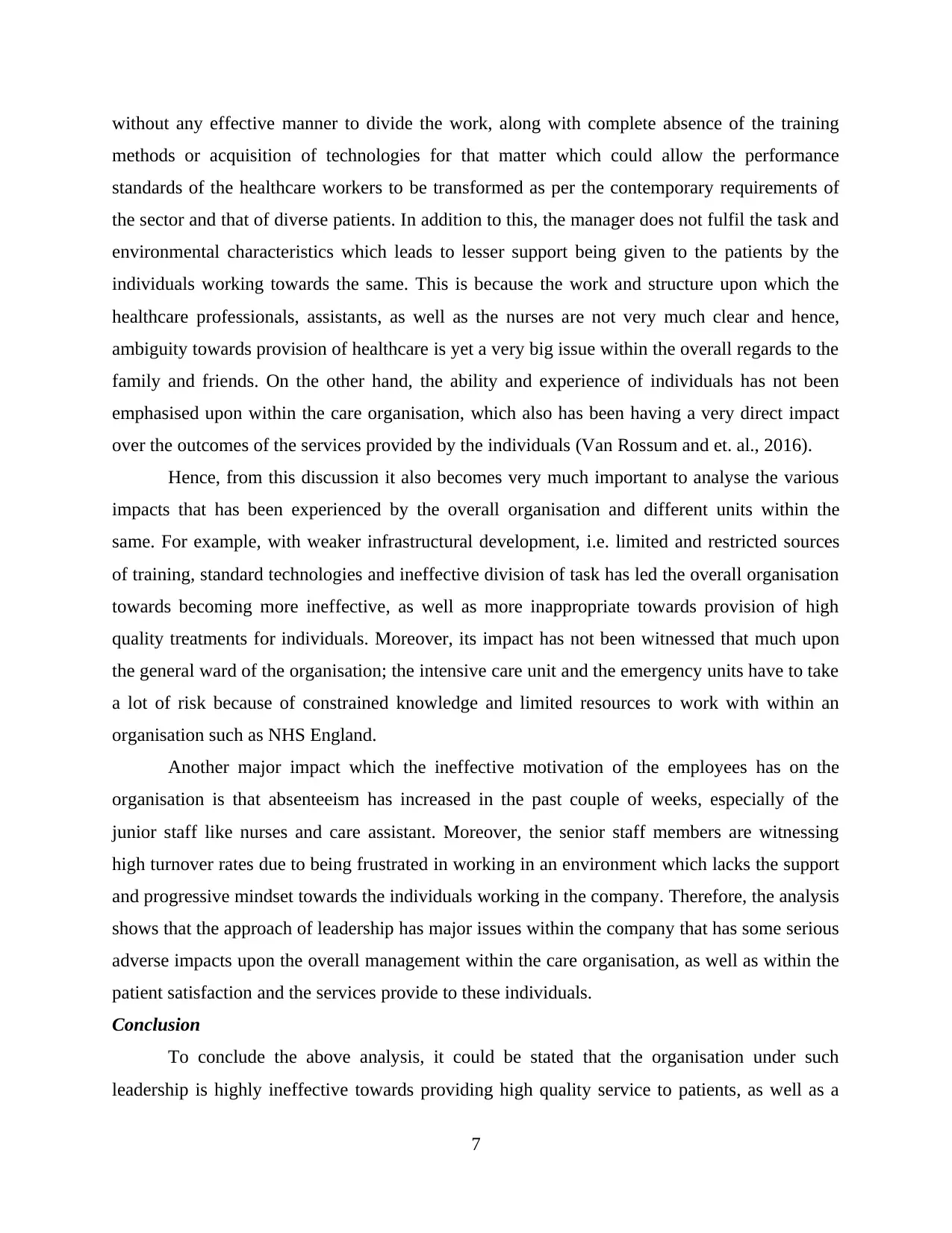
without any effective manner to divide the work, along with complete absence of the training
methods or acquisition of technologies for that matter which could allow the performance
standards of the healthcare workers to be transformed as per the contemporary requirements of
the sector and that of diverse patients. In addition to this, the manager does not fulfil the task and
environmental characteristics which leads to lesser support being given to the patients by the
individuals working towards the same. This is because the work and structure upon which the
healthcare professionals, assistants, as well as the nurses are not very much clear and hence,
ambiguity towards provision of healthcare is yet a very big issue within the overall regards to the
family and friends. On the other hand, the ability and experience of individuals has not been
emphasised upon within the care organisation, which also has been having a very direct impact
over the outcomes of the services provided by the individuals (Van Rossum and et. al., 2016).
Hence, from this discussion it also becomes very much important to analyse the various
impacts that has been experienced by the overall organisation and different units within the
same. For example, with weaker infrastructural development, i.e. limited and restricted sources
of training, standard technologies and ineffective division of task has led the overall organisation
towards becoming more ineffective, as well as more inappropriate towards provision of high
quality treatments for individuals. Moreover, its impact has not been witnessed that much upon
the general ward of the organisation; the intensive care unit and the emergency units have to take
a lot of risk because of constrained knowledge and limited resources to work with within an
organisation such as NHS England.
Another major impact which the ineffective motivation of the employees has on the
organisation is that absenteeism has increased in the past couple of weeks, especially of the
junior staff like nurses and care assistant. Moreover, the senior staff members are witnessing
high turnover rates due to being frustrated in working in an environment which lacks the support
and progressive mindset towards the individuals working in the company. Therefore, the analysis
shows that the approach of leadership has major issues within the company that has some serious
adverse impacts upon the overall management within the care organisation, as well as within the
patient satisfaction and the services provide to these individuals.
Conclusion
To conclude the above analysis, it could be stated that the organisation under such
leadership is highly ineffective towards providing high quality service to patients, as well as a
7
methods or acquisition of technologies for that matter which could allow the performance
standards of the healthcare workers to be transformed as per the contemporary requirements of
the sector and that of diverse patients. In addition to this, the manager does not fulfil the task and
environmental characteristics which leads to lesser support being given to the patients by the
individuals working towards the same. This is because the work and structure upon which the
healthcare professionals, assistants, as well as the nurses are not very much clear and hence,
ambiguity towards provision of healthcare is yet a very big issue within the overall regards to the
family and friends. On the other hand, the ability and experience of individuals has not been
emphasised upon within the care organisation, which also has been having a very direct impact
over the outcomes of the services provided by the individuals (Van Rossum and et. al., 2016).
Hence, from this discussion it also becomes very much important to analyse the various
impacts that has been experienced by the overall organisation and different units within the
same. For example, with weaker infrastructural development, i.e. limited and restricted sources
of training, standard technologies and ineffective division of task has led the overall organisation
towards becoming more ineffective, as well as more inappropriate towards provision of high
quality treatments for individuals. Moreover, its impact has not been witnessed that much upon
the general ward of the organisation; the intensive care unit and the emergency units have to take
a lot of risk because of constrained knowledge and limited resources to work with within an
organisation such as NHS England.
Another major impact which the ineffective motivation of the employees has on the
organisation is that absenteeism has increased in the past couple of weeks, especially of the
junior staff like nurses and care assistant. Moreover, the senior staff members are witnessing
high turnover rates due to being frustrated in working in an environment which lacks the support
and progressive mindset towards the individuals working in the company. Therefore, the analysis
shows that the approach of leadership has major issues within the company that has some serious
adverse impacts upon the overall management within the care organisation, as well as within the
patient satisfaction and the services provide to these individuals.
Conclusion
To conclude the above analysis, it could be stated that the organisation under such
leadership is highly ineffective towards providing high quality service to patients, as well as a
7
⊘ This is a preview!⊘
Do you want full access?
Subscribe today to unlock all pages.

Trusted by 1+ million students worldwide
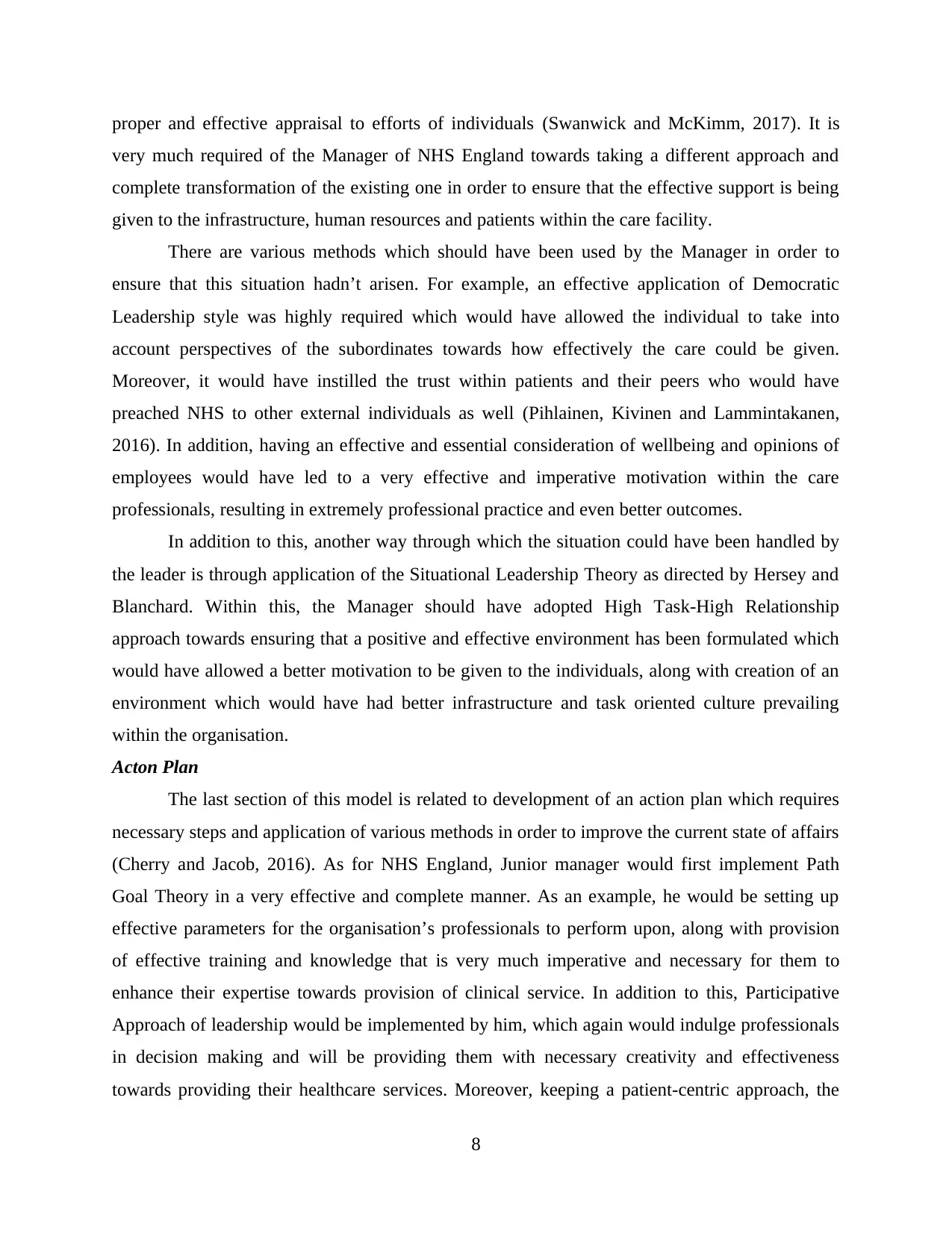
proper and effective appraisal to efforts of individuals (Swanwick and McKimm, 2017). It is
very much required of the Manager of NHS England towards taking a different approach and
complete transformation of the existing one in order to ensure that the effective support is being
given to the infrastructure, human resources and patients within the care facility.
There are various methods which should have been used by the Manager in order to
ensure that this situation hadn’t arisen. For example, an effective application of Democratic
Leadership style was highly required which would have allowed the individual to take into
account perspectives of the subordinates towards how effectively the care could be given.
Moreover, it would have instilled the trust within patients and their peers who would have
preached NHS to other external individuals as well (Pihlainen, Kivinen and Lammintakanen,
2016). In addition, having an effective and essential consideration of wellbeing and opinions of
employees would have led to a very effective and imperative motivation within the care
professionals, resulting in extremely professional practice and even better outcomes.
In addition to this, another way through which the situation could have been handled by
the leader is through application of the Situational Leadership Theory as directed by Hersey and
Blanchard. Within this, the Manager should have adopted High Task-High Relationship
approach towards ensuring that a positive and effective environment has been formulated which
would have allowed a better motivation to be given to the individuals, along with creation of an
environment which would have had better infrastructure and task oriented culture prevailing
within the organisation.
Acton Plan
The last section of this model is related to development of an action plan which requires
necessary steps and application of various methods in order to improve the current state of affairs
(Cherry and Jacob, 2016). As for NHS England, Junior manager would first implement Path
Goal Theory in a very effective and complete manner. As an example, he would be setting up
effective parameters for the organisation’s professionals to perform upon, along with provision
of effective training and knowledge that is very much imperative and necessary for them to
enhance their expertise towards provision of clinical service. In addition to this, Participative
Approach of leadership would be implemented by him, which again would indulge professionals
in decision making and will be providing them with necessary creativity and effectiveness
towards providing their healthcare services. Moreover, keeping a patient-centric approach, the
8
very much required of the Manager of NHS England towards taking a different approach and
complete transformation of the existing one in order to ensure that the effective support is being
given to the infrastructure, human resources and patients within the care facility.
There are various methods which should have been used by the Manager in order to
ensure that this situation hadn’t arisen. For example, an effective application of Democratic
Leadership style was highly required which would have allowed the individual to take into
account perspectives of the subordinates towards how effectively the care could be given.
Moreover, it would have instilled the trust within patients and their peers who would have
preached NHS to other external individuals as well (Pihlainen, Kivinen and Lammintakanen,
2016). In addition, having an effective and essential consideration of wellbeing and opinions of
employees would have led to a very effective and imperative motivation within the care
professionals, resulting in extremely professional practice and even better outcomes.
In addition to this, another way through which the situation could have been handled by
the leader is through application of the Situational Leadership Theory as directed by Hersey and
Blanchard. Within this, the Manager should have adopted High Task-High Relationship
approach towards ensuring that a positive and effective environment has been formulated which
would have allowed a better motivation to be given to the individuals, along with creation of an
environment which would have had better infrastructure and task oriented culture prevailing
within the organisation.
Acton Plan
The last section of this model is related to development of an action plan which requires
necessary steps and application of various methods in order to improve the current state of affairs
(Cherry and Jacob, 2016). As for NHS England, Junior manager would first implement Path
Goal Theory in a very effective and complete manner. As an example, he would be setting up
effective parameters for the organisation’s professionals to perform upon, along with provision
of effective training and knowledge that is very much imperative and necessary for them to
enhance their expertise towards provision of clinical service. In addition to this, Participative
Approach of leadership would be implemented by him, which again would indulge professionals
in decision making and will be providing them with necessary creativity and effectiveness
towards providing their healthcare services. Moreover, keeping a patient-centric approach, the
8
Paraphrase This Document
Need a fresh take? Get an instant paraphrase of this document with our AI Paraphraser
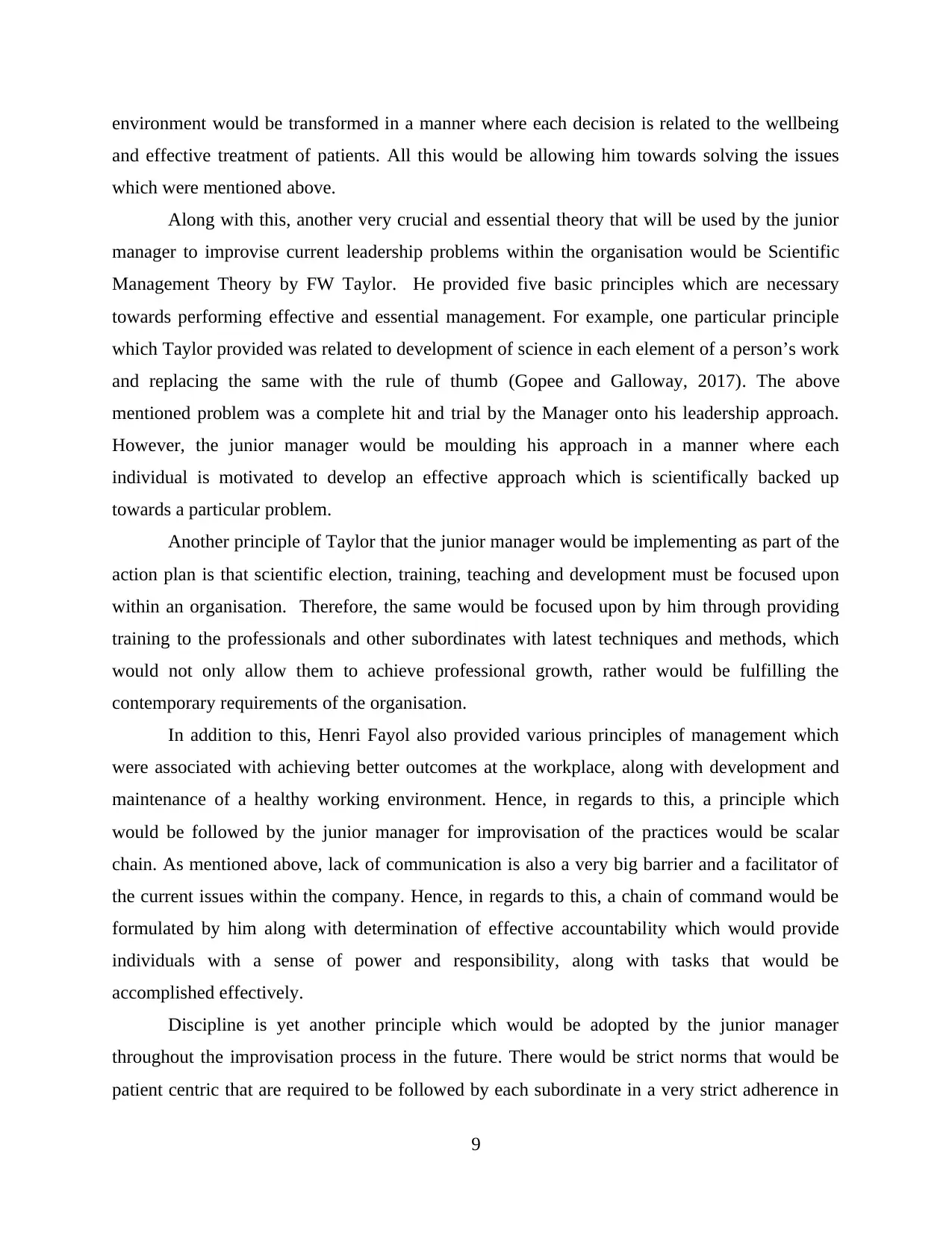
environment would be transformed in a manner where each decision is related to the wellbeing
and effective treatment of patients. All this would be allowing him towards solving the issues
which were mentioned above.
Along with this, another very crucial and essential theory that will be used by the junior
manager to improvise current leadership problems within the organisation would be Scientific
Management Theory by FW Taylor. He provided five basic principles which are necessary
towards performing effective and essential management. For example, one particular principle
which Taylor provided was related to development of science in each element of a person’s work
and replacing the same with the rule of thumb (Gopee and Galloway, 2017). The above
mentioned problem was a complete hit and trial by the Manager onto his leadership approach.
However, the junior manager would be moulding his approach in a manner where each
individual is motivated to develop an effective approach which is scientifically backed up
towards a particular problem.
Another principle of Taylor that the junior manager would be implementing as part of the
action plan is that scientific election, training, teaching and development must be focused upon
within an organisation. Therefore, the same would be focused upon by him through providing
training to the professionals and other subordinates with latest techniques and methods, which
would not only allow them to achieve professional growth, rather would be fulfilling the
contemporary requirements of the organisation.
In addition to this, Henri Fayol also provided various principles of management which
were associated with achieving better outcomes at the workplace, along with development and
maintenance of a healthy working environment. Hence, in regards to this, a principle which
would be followed by the junior manager for improvisation of the practices would be scalar
chain. As mentioned above, lack of communication is also a very big barrier and a facilitator of
the current issues within the company. Hence, in regards to this, a chain of command would be
formulated by him along with determination of effective accountability which would provide
individuals with a sense of power and responsibility, along with tasks that would be
accomplished effectively.
Discipline is yet another principle which would be adopted by the junior manager
throughout the improvisation process in the future. There would be strict norms that would be
patient centric that are required to be followed by each subordinate in a very strict adherence in
9
and effective treatment of patients. All this would be allowing him towards solving the issues
which were mentioned above.
Along with this, another very crucial and essential theory that will be used by the junior
manager to improvise current leadership problems within the organisation would be Scientific
Management Theory by FW Taylor. He provided five basic principles which are necessary
towards performing effective and essential management. For example, one particular principle
which Taylor provided was related to development of science in each element of a person’s work
and replacing the same with the rule of thumb (Gopee and Galloway, 2017). The above
mentioned problem was a complete hit and trial by the Manager onto his leadership approach.
However, the junior manager would be moulding his approach in a manner where each
individual is motivated to develop an effective approach which is scientifically backed up
towards a particular problem.
Another principle of Taylor that the junior manager would be implementing as part of the
action plan is that scientific election, training, teaching and development must be focused upon
within an organisation. Therefore, the same would be focused upon by him through providing
training to the professionals and other subordinates with latest techniques and methods, which
would not only allow them to achieve professional growth, rather would be fulfilling the
contemporary requirements of the organisation.
In addition to this, Henri Fayol also provided various principles of management which
were associated with achieving better outcomes at the workplace, along with development and
maintenance of a healthy working environment. Hence, in regards to this, a principle which
would be followed by the junior manager for improvisation of the practices would be scalar
chain. As mentioned above, lack of communication is also a very big barrier and a facilitator of
the current issues within the company. Hence, in regards to this, a chain of command would be
formulated by him along with determination of effective accountability which would provide
individuals with a sense of power and responsibility, along with tasks that would be
accomplished effectively.
Discipline is yet another principle which would be adopted by the junior manager
throughout the improvisation process in the future. There would be strict norms that would be
patient centric that are required to be followed by each subordinate in a very strict adherence in
9
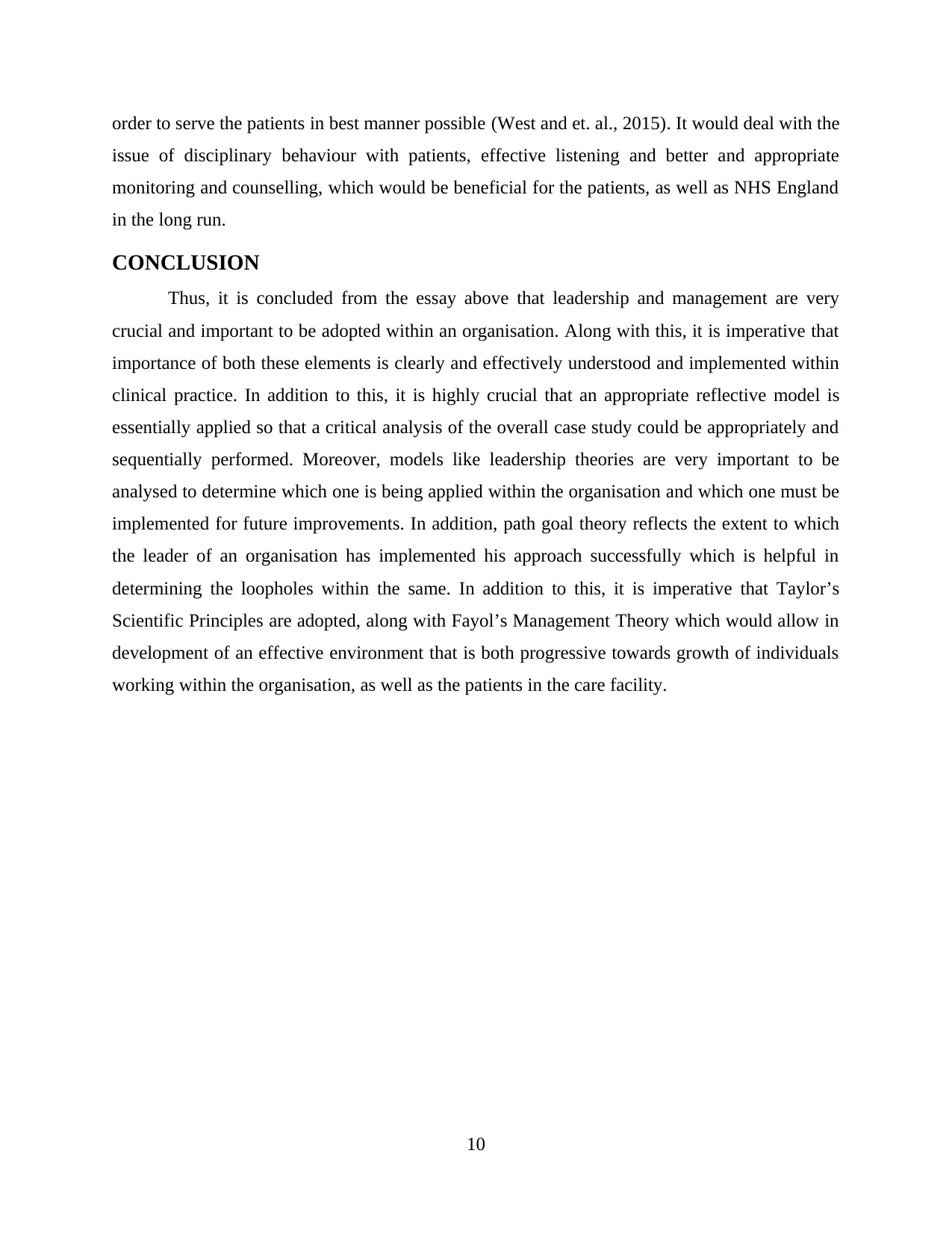
order to serve the patients in best manner possible (West and et. al., 2015). It would deal with the
issue of disciplinary behaviour with patients, effective listening and better and appropriate
monitoring and counselling, which would be beneficial for the patients, as well as NHS England
in the long run.
CONCLUSION
Thus, it is concluded from the essay above that leadership and management are very
crucial and important to be adopted within an organisation. Along with this, it is imperative that
importance of both these elements is clearly and effectively understood and implemented within
clinical practice. In addition to this, it is highly crucial that an appropriate reflective model is
essentially applied so that a critical analysis of the overall case study could be appropriately and
sequentially performed. Moreover, models like leadership theories are very important to be
analysed to determine which one is being applied within the organisation and which one must be
implemented for future improvements. In addition, path goal theory reflects the extent to which
the leader of an organisation has implemented his approach successfully which is helpful in
determining the loopholes within the same. In addition to this, it is imperative that Taylor’s
Scientific Principles are adopted, along with Fayol’s Management Theory which would allow in
development of an effective environment that is both progressive towards growth of individuals
working within the organisation, as well as the patients in the care facility.
10
issue of disciplinary behaviour with patients, effective listening and better and appropriate
monitoring and counselling, which would be beneficial for the patients, as well as NHS England
in the long run.
CONCLUSION
Thus, it is concluded from the essay above that leadership and management are very
crucial and important to be adopted within an organisation. Along with this, it is imperative that
importance of both these elements is clearly and effectively understood and implemented within
clinical practice. In addition to this, it is highly crucial that an appropriate reflective model is
essentially applied so that a critical analysis of the overall case study could be appropriately and
sequentially performed. Moreover, models like leadership theories are very important to be
analysed to determine which one is being applied within the organisation and which one must be
implemented for future improvements. In addition, path goal theory reflects the extent to which
the leader of an organisation has implemented his approach successfully which is helpful in
determining the loopholes within the same. In addition to this, it is imperative that Taylor’s
Scientific Principles are adopted, along with Fayol’s Management Theory which would allow in
development of an effective environment that is both progressive towards growth of individuals
working within the organisation, as well as the patients in the care facility.
10
⊘ This is a preview!⊘
Do you want full access?
Subscribe today to unlock all pages.

Trusted by 1+ million students worldwide
1 out of 13
Related Documents
Your All-in-One AI-Powered Toolkit for Academic Success.
+13062052269
info@desklib.com
Available 24*7 on WhatsApp / Email
![[object Object]](/_next/static/media/star-bottom.7253800d.svg)
Unlock your academic potential
Copyright © 2020–2025 A2Z Services. All Rights Reserved. Developed and managed by ZUCOL.





